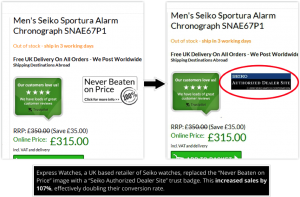“We don’t act when we don’t trust you”
We are a suspicious species. Therefore trust is a very important factor when it comes to online persuasion. Corritore et. al (2003) define online trust as follows: “an attitude of confident expectation in an online situation of risk that one’s vulnerabilities will not be exploited”.
So if we’re confident that our vulnerabilities will not be exploited, we’re more likely to act.
Scientific Review:
Beldad, The Young & Steehouder (2010) did a meta analysis and identified the following key elements that increase online trust:
- Perceived ease of use of the website
When a website is easy to use we trust it more. - Information quality
We’re likely to trust websites that are free from errors and contain accurate, current and complete information - Graphical characteristics
A websites’ Look & Feel can augment our feelings of trustworthiness (e.g. colors of low brightness are perceived as more trustworthy than bright colors) - Social presence cues
The perceived presence of ‘others’ increases online trust (be aware: photos of people usually do nothing for online trust!) - Customization and personalization capacity
When we can adjust products to our preferences, our trust increases - Privacy assurances and security features
The mere presence of a privacy policy and secure connections are enough to make us trust a website - Third party guarantees
Especially when we visit a website for the first time, third-party guarantees can bolster our trust
Online Persuasion tips:
Increase your customers’ trust in you by creating a website or app that:
[checklist]
- Is very easy to use
- Has perfect quality content
- Looks & feels solid
- Shows the presence of others (e.g. FaceBook likes)
- Allows for customization
- Is secure
- And uses 3rd party trust logo’s
[/checklist]
A/B Test:
HP-Group, a digital marketing agency tested trust for their client Express Watches (a UK based online retailer of Seiko watches). To ensure that customers trusted the originality of their Seiko watches, HP-Group placed a trust logo. It more than doubled the conversion!
Further reading on Trust:
- Corritore, Krachera & Wiedenbeck. Int. J. Human-Computer Studies 58 (2003) 737–758.
- Beldad, A., De Jong, M.D.T. & Steehouder, M.F. (2010) How shall I trust the faceless and the intangible? A literature review on the antecedents of online trust. Computers in Human Behavior 26 (5), 857–869.
- (and only for Dutch @Draaijerb’s blog on MarketingFacts)


